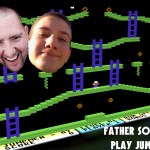Dragon’s Lair is considered a legendary title in video game history, but Brain Dead 13, while not nearly as iconic was a blast in its own way and a title that fans of animated FMV games will totally enjoy.
The game’s developer, David Quesnelle admits the arcade scene of the ‘70s and ‘80s had an effect on him as a developer. That simple twitch-inspired gameplay that powered Dragon’s Lair is absolutely fuel for the Braindead 13 formula.
Released on the Atari Jaguar, 3DO, DOS, Sega Saturn and Sony PlayStation, where it sold 20,000 copies, Brain Dead 13 was a different type of animal than Dragon’s Lair, in spite of several similarities. This time, there’s no Dirk the Daring as the hero. This time, there’s Lance, the world’s hippest computer repair guru. Summoned to the castle of the disembodied brain, Dr. Nero Neurosis, you learn of the Doctor’s master plan. Along the way, you’ll meet several of the doctor’s allies, Moose, Vivi and the game’s most fiercest baddie, Fritz, the half-human half-pet of the game’s antagonist, Dr. Neurosis. It’s here where the game truly separates itself from Dragon’s Lair as Fritz’s bloodthirsty antics give the game a far different tone.
Despite mirroring the Dragon’s Lair gameplay formula, Quesnelle leaned more on his animation skills during the cycle because that’s where his skill set resided. As a result, you might even say BD13 featured better visuals than the iconic Dragon’s Lair.
“Yes I was a gamer, but the games I had access to is Pong and arcade games of the ‘80s, not near the gaming they have now,” Quesnelle said. “I worked at Nelvana and other studios as an Animation designer, animator, storyboard artist, layout. I also was into computers and programming. I was a terrible programmer, but I could talk with programmers to bridge the artist and programmer gap. I was Producer, Director, one of the game designers, one of the animation designers. I even got to animate on it.”
Not ironically enough, the game’s development cycle felt very much like the creation of animated film.
“As Ricardo (Durante) produced the fantastic complicated story boards, each decision point could have up to five choices so Patty the production manager would pin the boards up on the walls thru out the studio,” Quesnelle said. “She came up with a system that allowed us to visually play the game on the walls without having to wait to program it. So if we wanted to play the game we just needed to go to the wall and play.”
With all of this responsibility and the animation-heavy design could have easily made the game’s development cycle a hectic one for anyone, but Quesnelle remembers it as a creative time in spite of the game being delayed a few times.
As a result, the team was forced to cut parts of the game that could have made for a far deeper animated experience.
“We had way more death and resurrection scenes planned but ran out of time,” Quesnelle said. “The game engine was based on the Dragon’s Lair engine with the intent to update the wait time, so we planned the boards and wait time very short to upload the user decision within one second, but a decision was not to put money into the update, so half way through storyboard, we had to add extra cycle animation between decisions to compensate for the longer wait time. That’s why Lance is always cycling looking left and right at every decision time to add a few seconds cycle for player to make button choice.”
While they weren’t able to put everything they wanted into the final product, Quesnelle is still happy with all the little odds and ends he was able to sneak in to make the game stand out. For many how play they game, they are some of Braindead 13’s most memorable moments.
“Since you would be seeing the same scenes over and over again we added as much easter eggs in the background as we could, like the Ark of the covenant and lots of crazy things so look closely or freeze frame it,” Quesnelle said. “That includes fast animated stuff like the props that fall out of Fritz’s vest as he falls down the fighting stairway at near the end of the game.”
Although it sold just 20,000 copies on the PlayStation (according to Quesnelle, the game had trouble selling in Japan because Lance only had three fingers) the game was far from a failure. While Dragon’s Lair was a huge hit in arcades and consoles, by the time the PlayStation was in millions of homes, the “control your own animated film” genre had simply run its course.
Gamers by 1995 wanted titles like Tekken and Ridge Racer. While painstakingly animated and polished, a game the likes of Braindead 13 just had a different audience. Regardless, the work taught Quesnelle plenty and even opened up other amazing opportunities in his career.
“Trust your crew and give them time and room to grow,” Quesnelle said. “After Readysoft was sold to a large game company many of the Braindead crew ended up working at Disney like myself and enjoyed working with them and other fantastic artists at Disney.”
The post How Dragon’s Lair Gave Birth to Brain Dead 13 appeared first on Old School Gamer Magazine.
